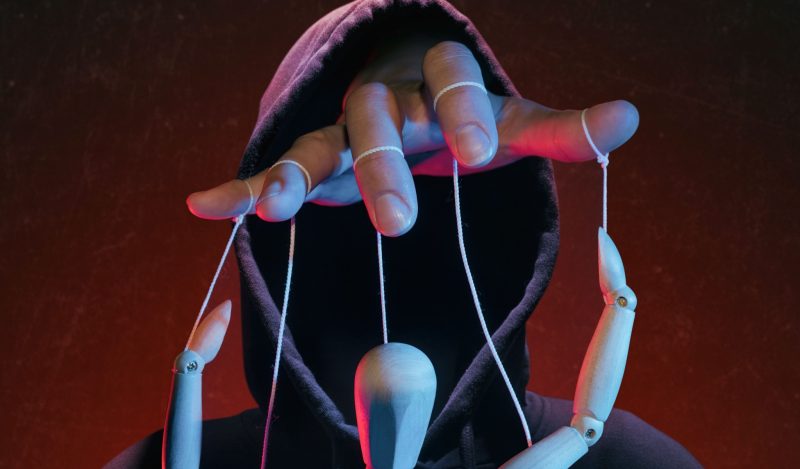Dr. Anthony Fauci, the nation’s longest-serving bureaucrat, as NIAID chief, funded various research projects, including (despite his vehement denials) the Wuhan China gain-of-function (GoF) endeavors that birthed pandemic Covid 19. Ironically, though Fauci deserves opprobrium, he emerged unscathed — moreover undergoing his own personal “gain-of-function;” amassing unprecedented influence. Initially (February 2020) branding the virus as ‘minuscule,’ he made a sharp pivot, recasting it as an apocalyptic threat despite open evidence to the contrary.
Through persistent back-channel information control, Fauci succeeded in choking off more temperate (and truthful) epidemiologic interpretations showing Covid as merely on par with a bad flu season (albeit without prior flu shot). In so doing, he created and then channeled the people’s fear effectively, coming to overshadow and undermine the president, as de facto commander in a new viral war. While Dr. Fauci thrived in the spotlight, his “gain-of-function” rendered him immune to caring overly about the concomitant ‘loss of function’ of the public’s liberty, economic stability, and psychosocial well-being.
Fauci’s Paradoxical Ascent: Gaining Functions Amidst a Pandemic
As COVID-19 unfolded, Dr. Anthony Fauci, NIAID chief, emerged as the central figure directing the global response. His directives, diverging from established scientific principles, subtly altered both the political and public health terrains. Mirroring China’s dramatic narratives, Fauci wielded unparalleled influence, distorted facts, and amplified public panic, all while ignoring the early, open data from the Diamond Princess cruise ship, which suggested a far less apocalyptic scenario than that depicted by China. This accessible information painted a picture ten times more hopeful for the US population than the dark vision propagated by China, yet the US aligned with China’s approach, adopting unprecedented lockdowns instead of the standard responses typically reserved for influenza-like outbreaks.
This crafted atmosphere not only facilitated the silencing of dissent and nurtured a new form of statism, but also systematically weakened then-President Donald Trump. Dr. Fauci’s strategy — incongruent with his previous stewardship of mild respiratory outbreaks (like original SARS, and avian- and swine- flus; 2003-9) — set a risky precedent, with the media’s echoing his narrative of control and fear from early 2020 onwards.
Having sponsored gain-of-function research in Wuhan, Fauci paradoxically experienced a personal “gain-of-function,” amassing unparalleled influence. Skillfully navigating the situation, he sidestepped blame, stifled discussions on lab leaks and non-lockdown approaches, and obscured his involvement in controversial research. Fauci also exhibited inconsistencies regarding vaccine efficacy. While his 2004 statements suggested skepticism towards vaccinating post-infection, he shifted in 2021. Initially doubtful about a vaccine’s success against rapidly transmitting COVID-19, he later championed vaccination — and even advocated boosters of ancestral SARS, akin to endorsing outdated flu shots.
Dr. Fauci seemed forthright outwardly, but his premature pronouncements’ reversals imply limited forethought. In February of 2020, Dr. Fauci told Americans,
- “If you look at the masks that you buy in a drug store, the leakage around that doesn’t really do much to protect you. Now, in the United States, there is absolutely no reason whatsoever to wear a mask.”
- Fauci asked people not to worry about coronavirus, the danger of which was “just minuscule.”
Subsequently, he pushed mask mandates. In May 2021 he admitted his own post-vaccination mask-wearing was a “signal” rather than necessary precaution – more of what Senator Rand Paul had labeled Fauci’s “public health theater.” As with all else, his stance shifts dramatically and quickly. These notable reversals, coupled with his ascent amidst manipulated narratives, necessitate a thorough examination of Fauci’s perplexing role and shifting stances during the pandemic response.
Fauci’s Medieval Turn
In early 2020, rather than maintaining a skeptical stance towards China’s motives in its (over-)dramatic portrayal of deaths in the streets, Dr. Fauci embraced its narrative without scrutiny. He guided the media‘s crafting of terror– e.g., in February 2020’s “To Take On the Coronavirus, Go Medieval on It.” Under Dr. Fauci’s aegis and with his blessing, the New York Times’ Donald McNeil set fear levels and expectations of disaster exceedingly high – at a fever pitch before any actual locally pitched fevers.
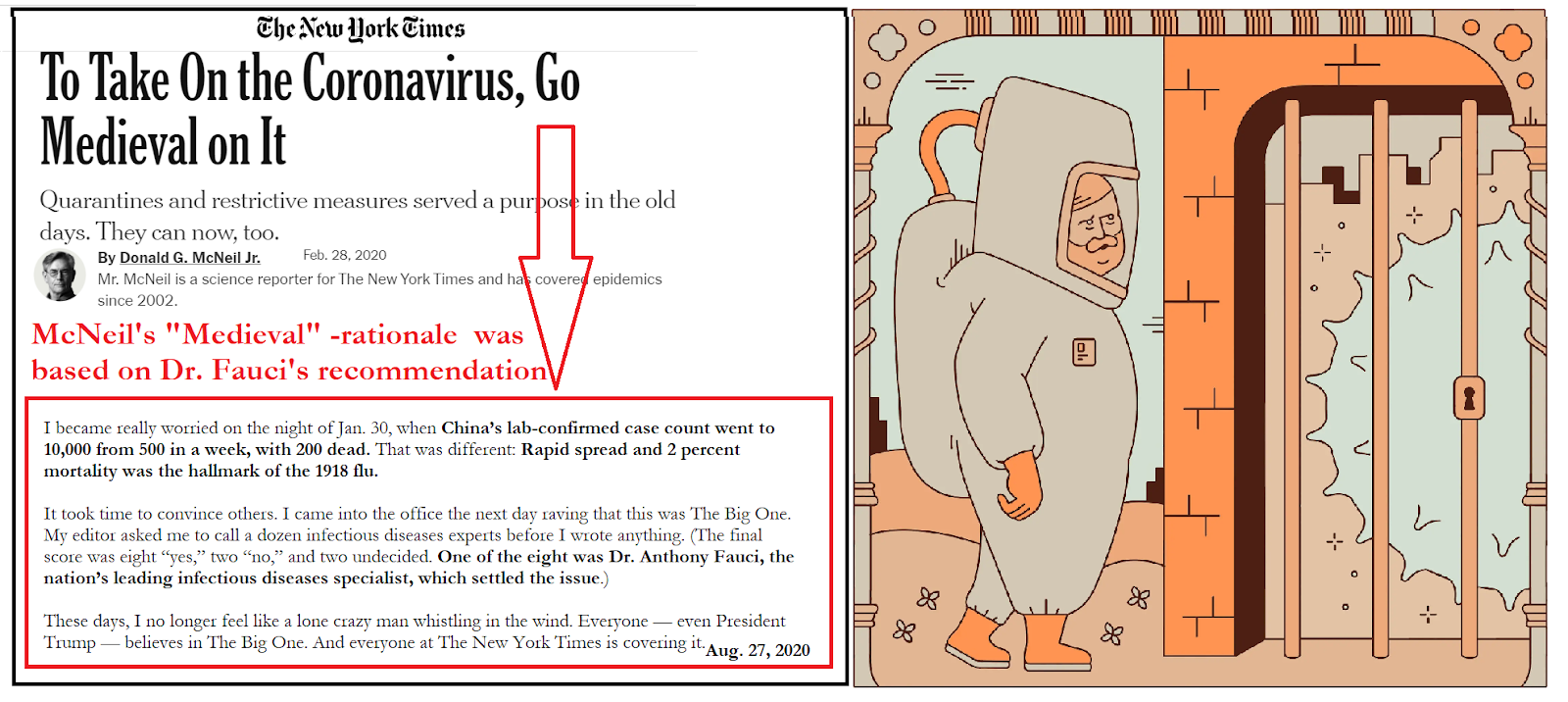
To fill in literally what Fauci (through his proxy, McNeil) meant, we have this:
“There are two ways to fight epidemics: the medieval and the modern.
- The modern way is to surrender to the power of the pathogens: Acknowledge that they are unstoppable and to try to soften the blow with 20th-century inventions, including new vaccines, antibiotics, hospital ventilators and thermal cameras searching for people with fevers.
- The medieval way, inherited from the era of the Black Death, is brutal: Close the borders, quarantine the ships, pen terrified citizens up inside their poisoned cities. For the first time in more than a century, the world has chosen to confront a new and terrifying virus with the iron fist instead of the latex glove.”
In pushing the ‘medieval’ approach, Dr. Fauci signaled alignment with China’s authoritarian response, an approach viable predominantly in societies where government decrees are unassailable. This advocated perspective harkens back to times when fear, not science, guided actions, leading to irrational and heinous practices – reminiscent of Jews’ being scapegoated and persecuted during the Black Death– ironically noted by a younger but wiser version of Mr. McNeil in 2009:
Whose fault was the Black Death? In medieval Europe, Jews were blamed so often, and so viciously, that it is surprising it was not called the Jewish Death. During the pandemic’s peak in Europe, from 1348 to 1351, more than 200 Jewish communities were wiped out, their inhabitants accused of spreading contagion or poisoning wells.
Ignoring Open Data: Fauci’s China Preference
Late January 2020 — at a crucial juncture, when public opinion was still malleable — an extraordinary real-world experiment unfolded, as the Diamond Princess cruise ship’s 3,711 occupants experienced a Wuhan-coronavirus outbreak. Simultaneously upsetting for quarantined vacationers and serendipitous for the world, this scenario provided epidemiologic data otherwise impossible ethically or logistically to create. Well aware of this unicorn event, Dr. Fauci announced to the Council on Foreign Relations (CFR): “You couldn’t ask for a better incubator for infection.”
At the time of this utterance, 24 days after the boat’s Hong Kong landing, there had not been a single fatality (although ultimately, by April — ten deaths [of median age 82] were (tenuously) attributed to coronavirus, albeit many months after initial exposure). Yet, in both his CFR speech and later discussions about variants of concern, Dr. Fauci heavily emphasized transmissibility, almost as if that were the primary threat. Yet the widespread nature of the banal illnesses such as cold sores and common colds underscores that transmissibility, per se, doesn’t equate to danger. The real public health concern is virulence, morbidity, and mortality. His fixation (within this speech) on an esoteric transmission event, the 2003 SARS plumbing flume incident between Hong Kong apartments, is misplaced and distracting.
Fully two months after exposure, the Diamond Princess’ data —showing minimal short-term mortality and risk primarily to the elderly— starkly contrasted with Dr. Fauci’s coincident March 11, 2020 claims to Congress of a mortality rate ’10 times’ that of seasonal flu, eerily mirroring China’s unreliable data. Reminiscent of the Marx Brothers, Fauci seemed to quip, ‘Who you gonna believe, me or your lying eyes?‘, sidelining the visible, unfolding evidence in favor of China’s dubious figures.
Fauci’s alarmist stance precipitated President Trump’s economy-shutting decision two days later. The good doctor’s embrace of unreliable foreign data over tangible findings ushered in unprecedented measures: business closures, relationship shifts, universal masking and distancing, and travel halts – societal responses never deployed for seasonal flu.
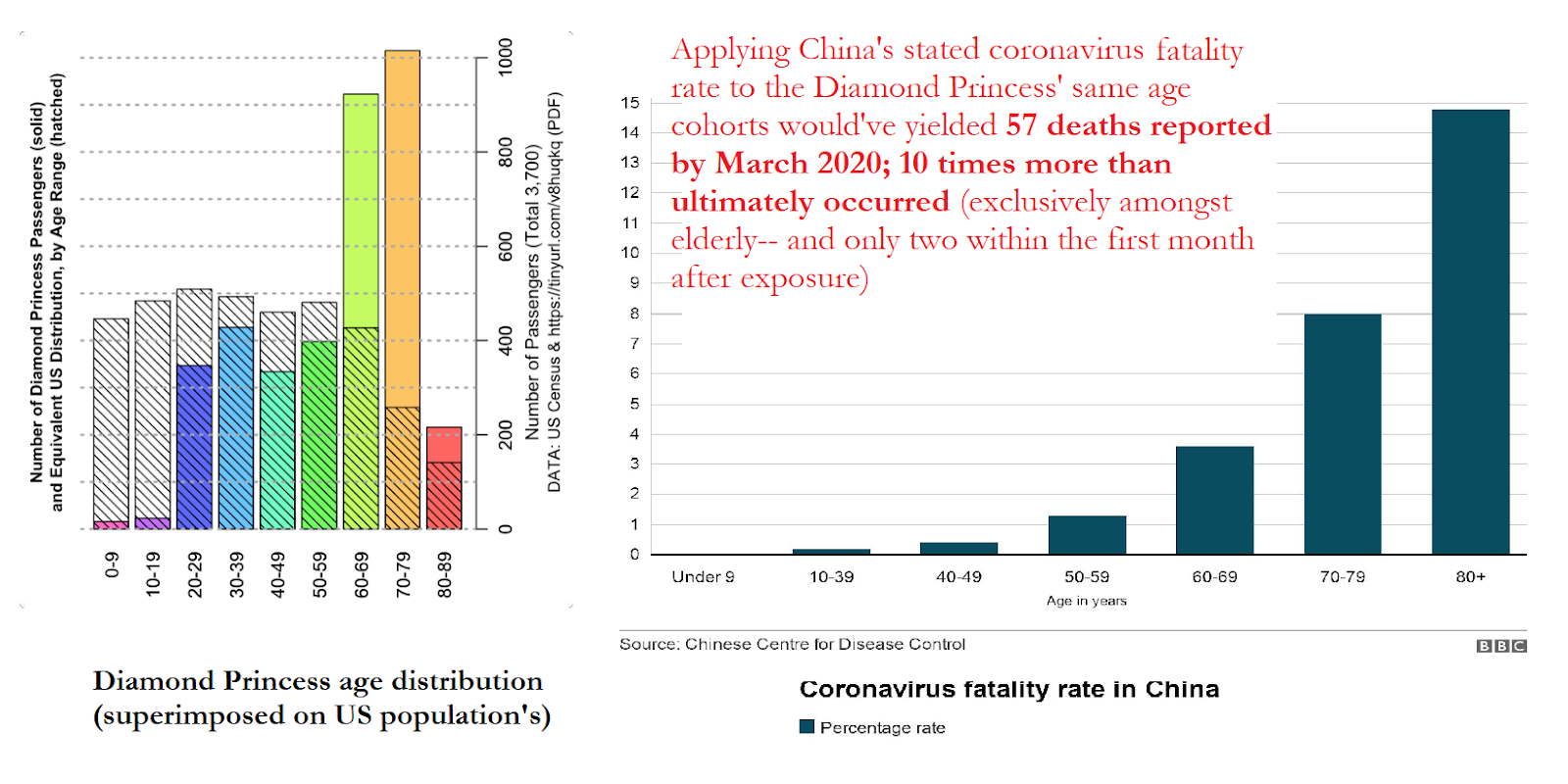
The time-window for influenza fatalities typically falls within 2-4 weeks after the onset of symptoms. Diamond Princess made its Hong Kong landfall on January 22. By mid-February, the unfolding scenario provided a wealth of actionable data. Notably, besides the low rate of disease incidence—with 83 percent of passengers remaining uninfected—three-quarters of the most vulnerable group, those aged over eighty, did not contract the virus. Furthermore, nearly half of those who tested positive for the disease were asymptomatic, including all children under ten and about half of the elderly passengers. This pattern of mild or non-existent symptoms in a significant proportion of infected individuals underscored that this was not the apocalyptic illness it was painted to be. This cruise ship’s crucial information could have served as our navigational chart: steering global response away from impending disaster.

Crucial Days in March: The Stealth Insurrection
Despite President Trump’s prolific Twitter activity, “Diamond Princess” is conspicuously absent. While Trump obviously and obliviously missed its significance, the onus nonetheless was on his team of medical experts to distill and communicate these critical findings. “The nation’s healer” Fauci in not giving (the people’s proxy) Mr. Trump the full truth committed (depending on one’s political stance – and using medical metaphor) either an indirect euthanasia to his term, or a negligent miscarriage of justice. Covid-response overkill broke the smooth-sailing symbiosis of Trump’s presidency with its robust economy.
Jeffrey Tucker observed a dramatic shift in Trump’s tweets mid-March 2020, possibly influenced by briefings hinting at COVID-19 as a Chinese bioweapon. Here’s a fictionalized conception:
Dr. Anthony Fauci, Michael Pottinger, and other officials approach President Trump, craftily using President Trump’s ego and patriotism against him.
They suggest: “Mr. President, you might be underestimating this virus. It’s not a typical flu-like virus; we suspect it may be a bioweapon from China. But the good news is that we’ve sequenced the virus and are developing a vaccine. By summer, we could distribute it widely. Handling this crisis effectively could greatly bolster your re-election prospects.”
Trump thereupon pivoted from viewing the virus as a (potentially tough) flu to an existential threat. His March 13, 2020 national emergency declaration opened the floodgates to public health experts’ restricting and redefining personal liberties under collective and unprecedented state “lockdowns.” This subterfuge undermined the President’s standing, melding global pandemic response with political maneuvering – almost as if Mr. Trump had been the actual ‘virus’ needing eradication.
And so it was done. Though absentee ballots had long been readily accessible, heightened pandemic fears drove an aggressive push for widespread mail-in ballots. This not only escalated risks of counterfeiting and harvesting but also induced lasting political shifts, with effects extending beyond the coronavirus era.
Dr FauC.I.A.?
New allegations have emerged, from the Select Subcommittee on the Coronavirus Pandemic’s Chairman Brad Wenstrup (R-Ohio), painting a perplexing narrative around Dr. Anthony Fauci’s possibly being influenced by the CIA (or vice versa). Within the emerging narrative, there appears to have been an attempt by the CIA to financially sway six analysts into altering their initial findings, which indicated a lab origin for SARS-CoV-2 in Wuhan. This attempt seemingly aimed at crafting an alternative narrative, serving as a smokescreen to obscure government involvement and funding in the hazardous gain-of-function research on coronaviruses in Wuhan.
Dr. Fauci does not appear to be a mere pawn. Notably, his stance on the virulence of the coronavirus underwent a significant shift within days of the alleged late February meeting with the CIA: from urging calm on day one to preparing for an impending health apocalypse the very next. Given Fauci’s well-documented affinity for the spotlight, a flair for dramatics, and antipathy towards President Trump, there’s compelling reason to believe he may have been a willing participant in this alleged orchestration.
“To convince the president to inadvertently play a hand in the dismantling of the U.S. economy would indeed be the ultimate coup de grace for the CIA.” Jeffrey A. Tucker
Opting for Venality: A Less Sinister Reading of Fauci’s Strategy
Fauci’s alignment with China’s narrative during the crisis might be perceived as seditious, seemingly serving as a Trojan Horse for the Democrats — or China. However, an alternative explanation could be that his motivations were far pettier and self-centered. Given his ties to Wuhan’s gain-of-function research, Fauci might have been acting protectively — in desperate, deflective attempts to preserve his authority and perceived expertise.
Governmental roles seldom attract the truly brilliant, creatively scientific minds; these positions often accommodate individuals more proficient at navigating bureaucratic corridors than making groundbreaking contributions to their fields. Fauci’s various flip-flops and his tendency to delve into intricate but not illuminating details may reflect a lack of vision to provide genuinely effective solutions; akin to physicians’ temporizing when prescribing antibiotics for a cold. Or it may just be this (in his own words):
“I am basically just a nerd. There are some people who fit work in around having fun and then there are others who like to work and have fun only occasionally,”
Dr. Fauci’s persistent refusal to acknowledge the potential lab origin of the virus is profoundly concerning. Recent revelations, particularly the hitherto-hidden emails from early 2020, paint a troubling picture; highlighting that Dr. Fauci was aware of NIAID’s funding gain-of-function research at the Wuhan Institute of Virology (WIV) from 2015 on. This knowledge not only implicates him in the chain of events that could have led to the pandemic but also raises significant doubts about his commitment to transparency and full disclosure.
In early 2020, questioned about SARS-CoV-2’s potential lab origin, Dr. Fauci was dismissive, asserting that the virus’ evolution outside of a lab environment was evident. Yet, his response cleverly sidestepped the fundamental concern: even if the 2003 SARS was originally “wild,” it could have been brought into the lab for gain-of-function research (which he sponsored) — and then released, either inadvertently or intentionally. With subtle, verbal legerdemain, Dr. Fauci mocks the idea of Covid-19’s being, at least partially, man-made via laboratory alterations — erroneously implying that it remained as “wild” as the 2003 SARS. This rhetorical move allows him to dismiss concerns about lab involvement without directly addressing them; obscuring the nuances between an originally naturally-occurring virus and its descendent as modified within a laboratory setting.
“Sure, but what if scientists found the virus outside the lab, brought it back, and then it escaped? But that means it was in the wild to begin with. That’s why I don’t get what they’re talking about [and] why I don’t spend a lot of time going in on this circular argument (sic).”
Dr. Anthony Fauci and Dr. Francis Collins, leading the NIAID and NIH, collaborated with fellow scientists actively to construct a narrative aimed at discrediting the lab-leak theory. They not only directed and approved the publication of a misleading paper intended to ‘disprove’ it but also influenced and reversed virologists’ initially expressed concerns of SARS-CoV-2’s showing genetic markings of lab manipulation.
“Dr. Kristian Andersen makes clear in his messages that the purpose of the “Proximal Origin” paper was to “disprove” the lab leak hypothesis. The (authors) made secret plans to engage in deceptive and unethical behavior and — to spread disinformation. Their conspiracy included coordinating with their “higher-ups” in the US and UK governments to deceive journalists.” ~ Via public.Substack.com’s Alex Gutentag, Leighton Woodhouse, and Michael Shellenberger
“Proximal Origin” co-author, Dr. Andrew Rambaut blurted
“Given the sh**-show that would happen if anyone serious accused the Chinese of even accidental release, my feeling is we should say that given there is no evidence of a specifically engineered virus, we cannot possibly distinguish between natural evolution and escape so we are content with ascribing it to a natural process,”
To which Andersen replied,
“Yup, I totally agree that that’s a very reasonable conclusion. Although I hate when politics is injected into science – but it’s impossible not to, especially given the circumstances,”
Having US-taxpayer-funded scientists prioritize appeasing China over engaging in genuine scientific inquiry highlights a climate of censorship and fear—elements common in China but historically alien to America’s mission. The present risk is that we might mirror a clone or vassal state, generating science dictated by political mandates rather than adhering to the defining principles of our nation – and of science, itself.
“It’s ironic, that these scientists who wanted to shut down conspiracy theories ended up starting their own conspiracy to prematurely dismiss a lab origin of Covid-19. Whether intentionally or not, their actions have steered a large portion of journalists and other scientists away from asking reasonable questions about how the pandemic started.” Broad Center’s Alina Chan
Focused Protection
Fauci and Collins extended their silencing tactics to other areas of pandemic response. The heads of NIAID and NIH didn’t merely guide public opinion; they sought to suppress alternatives from respected peers, like those proposing “Focused Protection” strategies found in the Great Barrington Declaration.
Collins, in particular, called for a swift ‘takedown’ of this alternative:
“There needs to be a quick and devastating published takedown of its premises, Is it underway? [labeling Drs. Jay Bhattacharya, Sunetra Gupta, and Martin Kulldorff of Stanford, Oxford, and Harvard, respectively] “a fringe component of epidemiology. This is not mainstream science. It’s dangerous.”
These consistent efforts to control the narrative and dismiss alternative strategies weren’t just about maintaining a united front; they actively suppressed scientific debate and sidelined potentially valuable insights during a global health crisis.
Dr. Fauci’s Political Tightrope
Dr. Fauci’s career has been marked by political agility and clever maneuvering. He is no stranger to the intricacies of public health and the delicate balance between safety measures and individual freedoms within a democratic society. It seems unlikely, prima facie, that he believed imposing the same draconian urban lockdowns seen in China could be a reasonable course of action within the United States. The term “lockdown” itself carries connotations of imprisonment, referencing the extreme measures taken to quell inmate riots in prisons.
Previous applications of lockdowns as “public health” measures have been limited to highly specialized cases.
- In 2008, South Africa’s Jose Pearson TB Hospital resorted to lockdowns within its confines, resembling a prison for the sick, encircled by three fences topped with coils of razor wire. This extreme isolation aimed to prevent the escape of drug-resistant tubercular patients, highlighting the exceptional nature of such measures.
- In 2015, Sierra Leone briefly implemented lockdowns during the Ebola outbreak, an extraordinary response to a highly contagious and deadly virus.
However, Dr. Fauci and Dr. Deborah Birx’s decision to impose nationwide lockdowns on the entire population during the COVID-19 pandemic stands in stark contrast to the localized restrictions aimed at the sick during the TB episode and the brief, days-long Ebola lockdown (which allowed religious exemptions). COVID-19 lockdowns were widespread and enduring, resembling prison sentences for an entire population compelled to stay put, with restrictions even on no-risk, solitary, outdoor activities such as walks, or swims in the ocean.
The only place lockdowns of this magnitude had been perpetrated was China, where entire apartment buildings were sealed off and welded shut. Regardless of the situation, replicating such brutal measures in democratic and supposedly civil societies was an extreme step that should never have been considered, especially in the presence of contrary evidence from the Diamond Princess. These lockdowns were not on par with the specialized responses to diseases like Ebola or drug-resistant tuberculosis, and their severity raised serious questions about the balance between public health measures and individual freedoms.
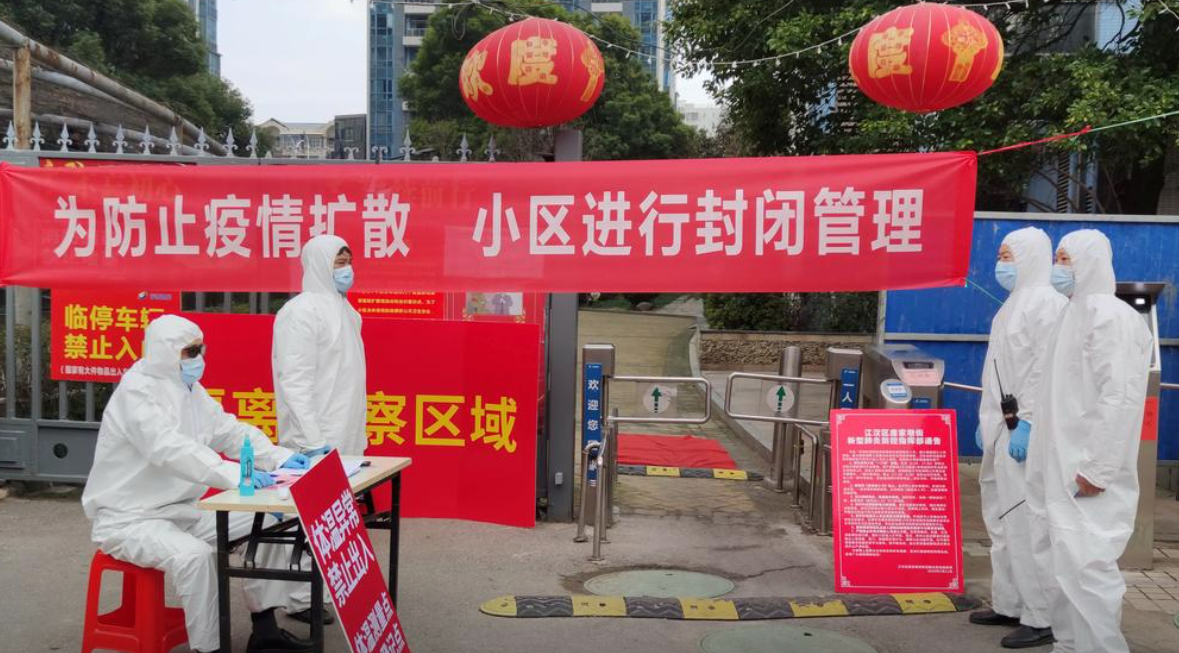
In a remarkable display of public opinion dynamics at what should have been the nadir of Dr. Anthony Fauci’s popularity amid stringent lockdowns and economic downturn, he experienced an unprecedented rise in public esteem, with a 77 percent approval rating, surpassing most governmental figures. He was lauded across media platforms (“a national treasure” – USA Today) and actively promoted as a safety guarantor during the crisis, casting a shadow over Mr. Trump (framed as endangering the public). This deliberate media narrative, emphasizing safety, enhanced Fauci’s image even as his recommended lockdowns precipitated considerable economic and societal turmoil.
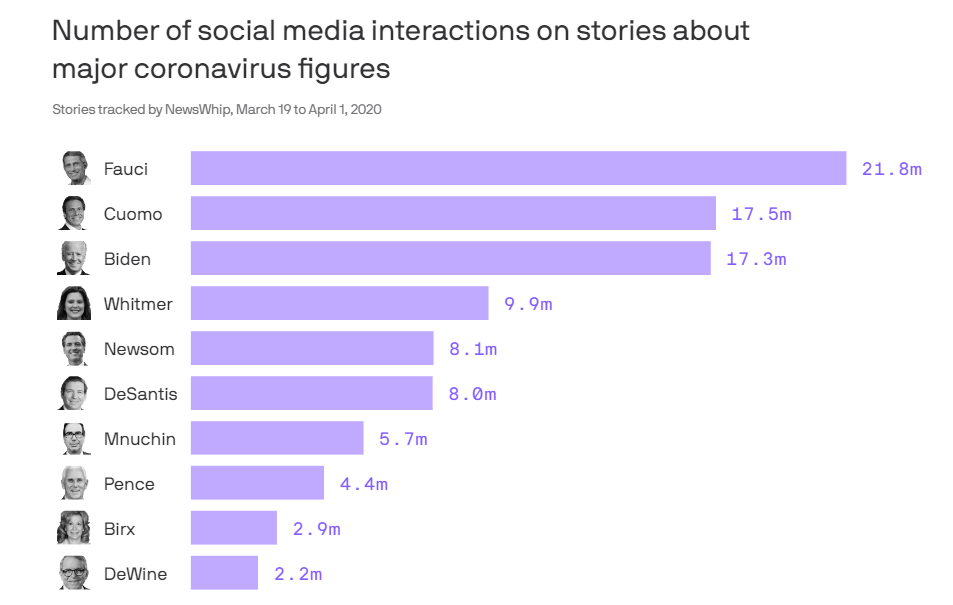
Dr. Fauci’s Enigmatic Involvement in Gain-of-Function Research
Dr. Fauci’s actions during the pandemic also raise questions about his involvement in gain-of-function research. Revelations from emails within NIAID and related agencies shed light on a long-term, taxpayer-funded engagement with the EcoHealth Alliance’s coronavirus gain-of-function research at WIV. This funding of offshore research, particularly in China, appears anomalous. Why did the US choose to fund such research in CCP China, rather than with trusted allies or in other reputable locales? While Wuhan was the site of the 2003 SARS outbreak, viruses are easily transportable for research purposes.
The original SARS virus was not exclusive to China; it was also present in Canada and likely other countries. Dr. Fauci’s willingness to engage in this research THERE may have stemmed from the belief that the knowledge gained was worth the potential risks. However, when the virus ultimately leaked from the Wuhan Institute of Virology, his initial bravado gave way to a mode of self-preservation and damage control.
Dr. Fauci’s response to the lab leak and his fervent defense of the “wet market” theory, despite its coincidental location in WIV’s Wuhan, suggests a point of vulnerability or guilt. He seemed determined to avoid any association with the worldwide virus outbreak, even if indirectly through the NGO EcoHealth Alliance’s involvement.
Alarm or Opportunism? Fauci’s Exaggerated Responses
Dr. Anthony Fauci has a track record of making alarming statements that can incite panic and fear among the public. One notable episode occurred in 1983 during the emergence of the HIV/AIDS crisis. In a Journal of the American Medical Association article, Dr. Fauci speculated about the possibility of HIV transmission within family households through routine close contact. While he cautiously noted the need for more evidence, the implications of his theory were staggering. Press accounts immediately seized upon Fauci’s commentary, propagating headlines like “Household contacts can transmit AIDS” and “Does AIDS spread by Routine Contact?” The panic generated by these statements in a time when HIV had no known cure or treatment and was primarily concentrated in specific high-risk groups cannot be overstated. Fauci’s lack of caution and care with his words in this instance raises questions about his approach to public communication.
Another instance of Dr. Fauci’s incautious statements occurred during the Zika virus outbreak in 2015-2016. The epidemic exclusively affected tropical regions, with Zika’s presence being evanescent — there in 2015, and gone by 2016. Despite this, Dr. Fauci illicitly diverted funding from other crucial medical areas to address Zika: plundering funds intended for cancer and diabetes research for the Zika effort.
In a striking move of hubris, Fauci, faced with over $100 million in unspent funds designated for Zika research—funds that Brazil ethically declined in 2018 due to the disappearance of the Zika-microcephaly phenomenon—ignored a 2017 NIH ethics panel’s advice and greenlit “human challenge trials” in Baltimore. Despite ethical reservations and the evaporation of the initial public health concern, Dr. Anna Durbin at Johns Hopkins now carries out these trials, injecting and infecting women with the Zika virus. The trials present a paradox: if Zika is dangerous, the study is unethical; if it’s not dangerous, the study is unnecessary. Yet, with funding as a driving force, the ethically dubious study continues, highlighting Fauci’s willingness to sidestep ethical guidelines and institutional checks for his objectives.
In a 2003 Financial Times feature, Fauci was lionized with ‘Can This Man Cure SARS?‘ despite no available cure. This enduring adulation hints at a cycle of mutual benefits between Fauci’s position at NIAID and journalists. Such ceaseless praise, without accountability for missteps, undoubtedly fostered imprudence in his actions.
Fauci’s Gain-of-Function: At the Expense of Science’s Loss…?
Amidst the intricate saga of Dr. Anthony Fauci’s professional conduct, there emerges a disturbing tableau of unbridled authority, intentional narrative manipulation, and a seemingly impervious reputation crafted, paradoxically, atop a foundation of inconsistencies and unilateral decisions. Such authoritarian dominance within the scientific community, historically embodied by regimes like the Soviets who held science hostage to the whims of power, ominously echoes in the corridors of America’s own institutions, where dissent is not merely discouraged but actively suppressed, and where funding becomes a tool of coercion rather than support for genuine, unfettered exploration. This is not merely about the legacy of one man but the soul of science itself, a soul that we must fight to preserve from the encroachment of shadows that threaten to silence the vibrant, necessary cacophony of scientific discourse in the interest of power and control.
However, the story doesn’t end with the distortion of the scientific enterprise alone. Dr. Fauci’s zealous pursuit of a singular vision, be it for self-preservation, political alignment, or perhaps a misguided interpretation of public health, casts a long shadow, the consequences of which we continue to grapple with as a society. Whether intentionally or not, his actions and recommendations — from endorsing lockdowns and masking mandates to ignoring the societal ramifications of such policies — have left indelible marks.
The casualties of this vision are not abstract. They are palpably evident in the plummeting reading scores among our nation’s underprivileged children, who, unlike their affluent counterparts, could ill afford to navigate the educational disruptions with the aid of technology and resources. They are visible in the shuttered facades of small businesses, unable to withstand the economic onslaught unleashed by protracted lockdowns, their dreams and livelihoods casually sacrificed at the altar of an elusive safetyism.
This isn’t merely about the legacy of an individual but an urgent call for introspection and reckoning with the values and principles we hold dear as a society and a scientific community. The soul of science is at stake here, and the shadows cast by authoritarian tendencies threaten to engulf the vibrant, robust tradition of scientific debate and discourse, replacing it with a monologue of power and control. We must ardently challenge and resist this narrative, for in its wake lies not just the integrity of science but the health and well-being of the public it vows to serve.
Published under a Creative Commons Attribution 4.0 International License
For reprints, please set the canonical link back to the original Brownstone Institute Article and Author.


